#comparing french and spanish
Text
La fangirl de Bruno or how close french and spanish can be
How it started
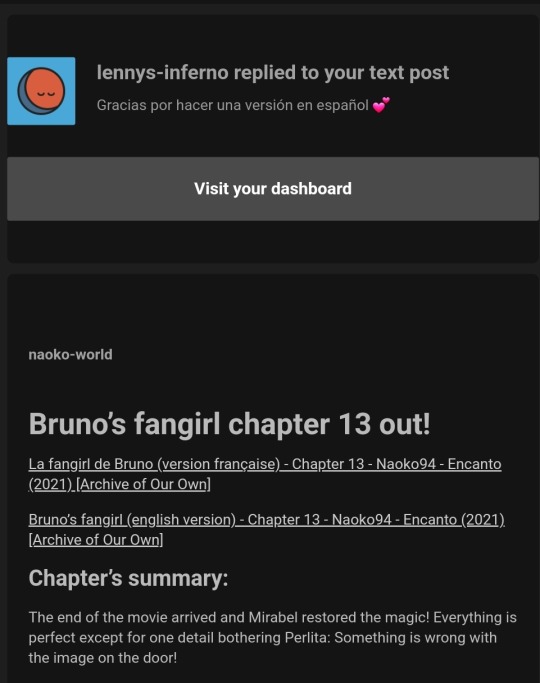
I received this notification one night (posted with the person's permission) and it honestly took me time understanding why I wasn't finding it in my post's replies.
I quickly figured the person simply thought La fangirl de Bruno was the Spanish version, understood their mistake and deleted it. I received a notification by mail though so...I saw.
My thoughts
I know I happened to saw people thinking french doesn't have anything in common with Italian/Spanish/Portuguese which...Actually isn't true! Just to see what french has in common with Spanish, like La & De, both words these two languages share.
As an example, there I didn't even need to translate to know that person was thanking me for writing a spanish version. Because I happen to know the words Gracias & Hacer, and because other words looks like their french counterpart.
por/pour
una/une
version/versión
en/en
español/espagnol
The mistake is understandable then, and they're not the only one to have made it since my friend @lunaencantada I love a lot and who is Spanish made the same.
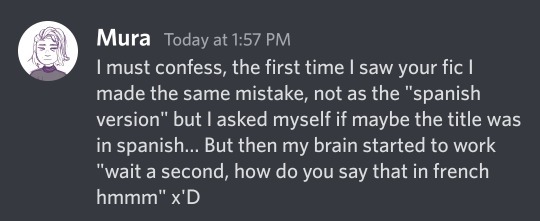
Eh! When watching Encanto in Spanish I realized some words I sometimes use in french (in familiar speech) are actually Spanish words. As an example I think of De Nada & Gratis we can say in french to say De rien (you're welcome) and Gratuit (free).
By the way, in my title I used the English word "fangirl" while I could have used the french word, "groupie", which is a word we don't really use anymore. This is why I chose "fangirl". However, if I had chosen it...Spanish-speakers people would still have been confused because it's "groupie" in Spanish too lol.
To go deeper into the subject:
According to Langfocus's video on how similar French and Spanish are both languages share about 75% of lexical similarity. It's less than Spanish and Italian (85%) or French and Italian (89%) but that's still a lot!



So why french sounds so different from the other latin language?
Because of pronunciation, some differences in basic conversation and in the word orders.
We french we tend to talk with Guttural and nasal sounds, or even not pronouncing some letters. Thus while Spanish pronounce all letters besides the h.

The order of some words is different too and Spanish is pro-dropping pronouns which was very confusing when I started learning Spanish.

Some words aren't the same either like the Langfocus guy talked about Pouvez-vous parler plus lentement/Puede hablar más despacio but if I could take any sentence and you could find one word or two that aren't the same.

As a much bigger example, coming back to Encanto, that part in No se habla de Bruno (We don't talk about Bruno) has some words I can recognize and some I can't.
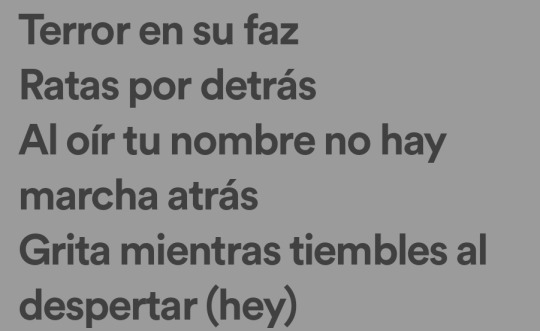
According to @lunaencantada it means
"Terror in his face
rats from behind
when you hear your name, there's no turning back
scream while you tremble when you wake up"
So in french it would literally be:
"Terreur sur son visage
Rats en guise de dos
Quand tu entends ton nom, pas de marche arrière
Cris en tremblant quand tu te réveilles"
Not exactly the same but we can guess because
terror/terreur,
en/en (sur),
Su/son
Faz/face (visage)
Ratas/Rats
por/por (en guise de)
Oír/entends (don't ask how I can easily guess Oír is entendre because I only suspect it's because of ouïe which is for the sense of hearing)
Tu/ton
Nom/nombre
No/non (pas)
Marcha/marche
Tiembles/tremble (tremblant)
While I couldn't recognize:
detrás/derrière (dos)
Al/Quand
Hay (se produire/être)
Atrás/arrière
Grita/cris
mientras/pendant (en)
despertar/se réveiller
Oh and funny thing:

There! This is roughly how close these two languages can be! For more infos you can watch the video by LangFocus which is much more complete and from which I used some graphics!
#spanish#french#la fangirl de Bruno#comparing french and spanish#how similar french and spanish are#no se habla de Bruno#wdtab
13 notes
·
View notes
Text
I think “there are many creators who don’t login to the qsmp as often as they used to” and “there are creators who continue to login consistently” are ideas that can coexist. I don’t know, I see lots of commentary on people who claim the qsmp is slow/feels empty right now vs. people emphasizing creators like tubbo/bagi/pac, who are online often. Those are both valid perspectives to have and either is understandable depending on whether you main someone who is/isn’t very active, that doesn’t necessarily mean the qsmp is “dead” (as I see people describing).
#qsmp#qsmp discourse#?#understand i am a little biased because most of the active playerbase rn speaks eng/ptbr and ive got a good hold on those#compared to like#viewers who speak french/spanish i could understand how the qsmp could be considered dead for them
23 notes
·
View notes
Text
One thing that always fucked with my head is aftg is how they manage to keep their languages skills with barely any practice
The vocabulary the pronunciation how to form a sentence how to conjugate a verb theese fly out the window real fast when you dont pratice
#languages go away really quickly#my spanish is still ok but nowhere near as good as when i lived there#actually it's 'comparable' to neil bc i lived in the country used it every day but came back quite a while ago#which he did by living in germany france and canada#also spanish is a latin language and bc i know french i know how close they are#(my only german i know is how to say 'i am a potato salad' so idk)#and let me tell you i would NOT be able to hold today the conversations neil is having#one day i'll try my best to translate in french what they say in the book but im too lazy#aftg#all for the game#tfc#the foxhole court#the raven king#trk#the king's men#tkm#neil josten
22 notes
·
View notes
Note
today i discovered there's a pokemon called Klinklang and that is such a funny word it brought me immense joy so thought id share
it’s even better than that!! Klinklang is the final evolution of two other pokemon
the first one is called Klink (can you tell where this is going already? 😉)

then this guy(s??) evolves into… guess what 🥰 Klang!!

so their final evolution is just those two names mushed together, which is both incredibly stupid and a stroke of pure genius that will never be repeated
(also the japanese name is Gigigiaru, which is just a nice word to pronounce 🥰🥰)
also i love the bulbapedia entry

it “may be a combination of klink and klang” be so for real right now
#pokemon names are so silly there’s one called Snom and one called torchic (fire chicken) and one called geodude (he’s a geode. and a dude)#there are literally dozens of stupid names but i adore them all & i’m glad this gen 5 cutie brought you joy 🥰🥰💖💖#also deino. he’s a dinosaur but small. a dino#the japanese & french & german names too are also so fun to compare#sometimes because i can read french i play the games in that to keep my literacy levels up & i’m always??? a wild WHAT appeared???#i can play the games in spanish too now mostly but the more intense dialogue sections take me ages to get through#because i have to look words up. but 🥰🥰 the dialogue can be slightly different in other languages which is really fun#anyway this made me happy to talk about so ty ty 🫂💖💖#anon
9 notes
·
View notes
Text
When I started the Portuguese tree (path?) on Duolingo, I was like, "Whoa! I can't reconcile what I hear with the letters I see!"
I'm used to Italian and Spanish, where I can pretty much figure out how to read a word even if I have no idea what it means. But I haven't figured out the pronunciation rules for Portuguese yet. Like, for instance, the letter o isn't pronounced how I think it is. Neither is the letter d. And the same vowel can be pronounced differently in the same word. And sometimes I can barely hear a vowel being pronounced at all. And sometimes there are a lot of vowels one after another!
But I'm on Unit 3 now and I'm starting to get used to how Portuguese sounds. I'm able to understand the basic words now.
I'm also starting to see the similarities to Spanish. For instance: sou (am) and soy; mulher (woman) and mujer. Some words are the same, like bebo (I drink) and como (I eat). I thought menino (boy) and menina (girl) were strange and long and hard to remember until I made the connection to Spanish niño and niña!
I'm also finding that my knowledge of French verb conjugation is helping me understand how verbs work in Portuguese. I haven't figured it out completely but I'm beginning to surmise that there are different categories of verbs, just like there are in French. For instance, I'm guessing that bebo and como are in the same category and I'm also guessing that they are regular verbs. First person singular (I) ends in -o (bebo, como); second person singular (you) ends in -es (bebes, comes); and third person singular (he/she/it) ends in -e (bebe, come).
Then there are verbs that don't follow that nice, neat pattern. Like leio (I read) and tenho (I have). I haven't quite figured out the conjugation rules or whether they are in the same category or not.
So that's where I'm at so far with Portuguese!

#portuguese language#learning portuguese#portuguese#duolingo#spanish language#french language#romance languages#comparative linguistics#linguistics#language learning#study languages
8 notes
·
View notes
Text
god i hope google translate japanese isnt anything like it is with latin
#i speak latin fun fact BUT holy shit the google translate for latin always comes out borderline nonsensical#which i get why bc a lot of latin is#idk how to describe this#contextual ig?? like a lot of the time translation work of a sentence comes from the context of that sentence#compared to latin english is an extremely wordy language#i really like languages and although i only speak two ive tried to learn more#including spanish french czech and german :D#i have a much harder time with nonwestern languages like japanese though bc duh im american so my language brain isnt wired for that#i think the language that always gave me the hardest time is any language in arabic script
11 notes
·
View notes
Text
Duolingo Sucks, Now What?: A Guide
Now that the quality of Duolingo has fallen (even more) due to AI and people are more willing to make the jump here are just some alternative apps and what languages they have:
"I just want an identical experience to DL"
Busuu (Languages: Spanish, Japanese, French, English, German, Dutch, Italian, Portuguese, Chinese, Polish, Turkish, Russian, Arabic, Korean)
"I want a good audio-based app"
Language Transfer (Languages: French, Swahili, Italian, Greek, German, Turkish, Arabic, Spanish, English for Spanish Speakers)
"I want a good audio-based app and money's no object"
Pimsleur (Literally so many languages)
Glossika (Also a lot of languages, but minority languages are free)
*anecdote: I borrowed my brother's Japanese Pimsleur CD as a kid and I still remember how to say the weather is nice over a decade later. You can find the CDs at libraries and "other" places I'm sure.
"I have a pretty neat library card"
Mango (Languages: So many and the endangered/Indigenous courses are free even if you don't have a library that has a partnership with Mango)
Transparent Language: (Languages: THE MOST! Also the one that has the widest variety of African languages! Perhaps the most diverse in ESL and learning a foreign language not in English)
"I want SRS flashcards and have an android"
AnkiDroid: (Theoretically all languages, pre-made decks can be found easily)
"I want SRS flashcards and I have an iphone"
AnkiApp: It's almost as good as AnkiDroid and free compared to the official Anki app for iphone
"I don't mind ads and just want to learn Korean"
lingory
"I want an app made for Mandarin that's BETTER than DL and has multiple languages to learn Mandarin in"
ChineseSkill (You can use their older version of the course for free)
"I don't like any of these apps you mentioned already, give me one more"
Bunpo: (Languages: Japanese, Spanish, French, German, Korean, and Mandarin)
#EDIT: Added a great resource for ESL and African languages that weren't found elsewhere#I do NOT recommend memrise and will talk about it another day but#langblr#duolingo#duo#language learning#language learning apps#mandarinblr#resource#reference
68K notes
·
View notes
Text
Duolingo is NOT what it used to be.
“Duolingo is ‘sunsetting the development of the Welsh course’ (and many others)”.
I’ve used Duolingo since 2013. It used to be about genuinely learning languages and preserving endangered ones. It used to have a vibrant community and forum where users were listened to. It used to have volunteers that dedicated countless hours and even years to making the best courses they could while also trying to explain extremely nuanced and complex grammar in simple terms.
In the past two years it feels like Von Ahn let the money talk instead of focusing on the original goal.
No one truly had a humongous problem with the subscription tier for SuperDuolingo. We understood it: if you can afford to pay, help keep Duolingo free for those who couldn’t.
It started when the company went public. Volunteers were leaving courses they created because they warned of differing longterm goals compared to Duolingo’s as a company; not long after it was announced that the incubator (how volunteers were able to make courses in the first place) would be shut down. A year goes by and the forums—the voice of the users and the way people were able to share tips and explanations—is discontinued. A year or two later, Duolingo gets a completely new makeover—the Tree is gone and you don’t control what lesson you start with. With the disappearance of the Tree, all grammar notes and explanations for courses not in the Big 8 (consisting of the courses made before the incubator like Spanish/French/German/etc. and of the most popular courses like Japanese/Korean/Chinese/etc.) are removed with it. Were you learning Vietnamese and have no idea how honorifics work without the grammar notes? Shit outta luck bud. Were you learning Polish and have absolutely no clue how one of the declensions newly thrown at you functions? Suck it up. In a Reddit AMA, Von Ahn claims that the new design resulted in more users utilizing the app/site. How he claims that statistic? By counting how many people log into their Duolingo account, as if an entire app renovation wouldn’t cause an uptick in numbers to even see what the fuck just happened to the courses.
Von Ahn announces next in a Reddit AMA that no more language courses will be added from what there already is available. His reasoning? No one uses the unpopular language courses — along with how Duolingo will now be doing upkeep with the courses already in place. And here I am, currently looking on the Duolingo website how there are 1.8 million active learners for Irish, 284 thousand active learners for Navajo, and even 934 thousand active learners for fucking High Valyrian. But yea, no one uses them. Not like the entire Navajo Nation population is 399k members or anything, or like 1.8 million people isn’t 36% of the entire population of Ireland or anything.
And now this. What happened to the upkeep of current courses? Oh, Von Ahn only meant the popular ones that already have infinite resources. Got it. Duolingo used to be a serious foundational resource for languages with little resources while also adding the relief of gamification.
It pisses me off. It really does. This was not what Duolingo started out as. And yea, maybe I shouldn’t get invested in a dingy little app. But as someone who spent most of her adolescence immersed in language learning to the point where it was literally keeping me alive at one point, to the point where languages felt like my only friend as a tween, and to the point where friendships on the Duolingo forums with likeminded individuals my age and other enthusiasts who even sent me books in other languages for free because they wanted people to learn it, the evolution of Duolingo hits a bitter nerve within me.
~End rant.
#duolingo#langblr#huge language rant feel free to skip#evolution of duolingo#luis von ahn#duolingo welsh course#language learning
17K notes
·
View notes
Text
Rewatch episodes in order nah I'm gonna rewatch the telescope I'm in a bojerb mood
#watching in English Japanese french and European Spanish i like to compare differences see which does it better#tho i think japan herb sucks while French is perfect
0 notes
Text
That viral video from last month of a giraffe pushing a tortoise was interesting to me because I saw it in French & Spanish corners of the internet and everyone was referring to the animals in the video as 'she' since giraffe & tortoise are feminine words, meanwhile on the English-speaking internet I saw a minority of people referring to them as 'it' or 'they', an overwhelming majority using masculine words, and almost no one use 'she'








Similarly romance language speakers humanised these animals using women's names while English speakers used men's names:


And of course it would have been different had the giraffe been an elephant (masculine word) but yeah I find it interesting that when it comes to personifying animals and things, speakers of gendered languages will go 50% masculine 50% feminine due to grammatical gender, while speakers of a non-gendered language with a neutral pronoun will go like 80% masculine 18% neutral 2% feminine.
It must feel weird to learn a gendered language and have to accept that a door is 'she', but it also feels weird to learn a non-gendered language like English and then scroll down hundreds of comments under an animal video and all the animals are 'he'. I'm reminded of a cartoon I saw on tumblr once with a speaking lightbulb, and all the comments referred to it as 'he' and a 'guy' (in french & spanish, people would call it she.) I wonder how it affects the way you frame the world in your mind? you ask a French kid to personify a spoon or a mouse or a raindrop, it's going to be a female character by default. I feel like that's something English speakers rarely consider—that compared to languages that are 'visibly', officially gendered in a 50/50 way, English is less neutral, and more masculine-gendered. When anglophones learn about grammatical gender they tend to react like "why is a chair a 'she' that's absurd?", but when the context calls for it they'll call a lightbulb 'he' without thinking about it
#language tag#the percentages in this post are not proven statistics they come from the Academy of Scrolling Down Tumblr Notes#(disclaimer)
1K notes
·
View notes
Text
Options are the 10 most spoken languages, listed with their number of total speakers for comparison to final results (Source)
Please share for sample size, I think it would be really interesting to compare the tumblr data set to the global data set!!
#poll#tumblr polls#my polls#polls#language#languages#spoken language#native language#global statistics#statistics#language poll
2K notes
·
View notes
Text
The word for 'I' has many different forms in the Romance languages, such as French je, Italian io, Portuguese eu and Spanish yo. Yet all these forms stem from one Latin word: egō. Here's how egō step by step changed into a selection of its Romance descendants.
People who subscribe to my Patreon get access to extra information further explaining what you see on the infographics and videos. To give you an impression, here's the text that goes with this video.
How did these forms originate?
Latin, Late Latin and Sardinian
Around the second century AD, the [g] sound of Latin egō (as in English go) started to weaken. It became a fricative sound similar to the one in Modern Spanish agua 'water'.
In this form, with only minor vowel changes, it survived until this very day in certain Nuorese dialects of Sardinian: ego. These geographically isolated dialects are known for being the most conservative descendants of Latin. Their most notable trait is the conservation of the Latin [k] and [g] sounds before i and e: Latin centum '100' with [k] became kentu, whereas in Italian it became cento with the [tʃ] sound of English check, and in French, Portuguese and many variaties of Spanish it respectively became cent, cento/cem and ciento/cien with [s].
In a Late Latin text from the 6th century, we encounter egō as eo. By this time, the consonant had been dropped. It's this form that's considered Proto-Romance, i.e. the form that gave birth to all descendants except the form in the Nuorese dialects I discussed above. Eo even remained practically intact in a number of other Nuorese dialects.
Portuguese and Romanian
In Portuguese and Romanian, the -o of eo became w-like: eu. However, the Romanian spelling hides the diphthongisation of [ɛ] to [jɛ], later [je]. Cfr. ferrum > fier, and pellem > piele.
Italian and Neapolitan
In Italian, [ɛ] became [e] and then [i], a sound close to it: io. This sound change didn't only happen in this word: compare mio 'my' (from Old Italian meo) and Dio 'God' (from Deo) with Portuguese meu and Deus. In Neapolitan, the -o weakened and became the schwa sound of English words like roses.
Spanish and French
The form io must have also existed in the distant ancestors of Spanish and French, but there, [i] didn't stop changing: it turned into a [j], its consonantal counterpart. In both languages, this [j] eventually underwent fortition: it became a stronger consonant similar to the one in English joke, which eventually weakened again in Modern French je.
In South American Spanish, interesting things are happening. The sound change that yo pronounced as [ʒo] has undergone in the Rioplatense dialects in Uruguay and the southern part of Argentina is called zheísmo, and what's happening in Buenos Aires and spreading through Argentina is called sheísmo: [ʃo].
#historical linguistics#linguistics#language#etymology#latin#french#spanish#old french#old spanish#romanian#sardinian#portuguese#italian#proto-romance#video#audio#lingblr#late latin
704 notes
·
View notes
Text
Let's talk costuming significance! Because there's some really interesting stuff going on!
So Zheng Yi Sao drops the soup bitch mask when she buys the Roman puzzle box full of indigo, correctly identifying it as extremely valuable. And there's a LOT going on there - because indigo dye has a long history of being a hot comodity, even being referred to as "blue gold", but along with that, especially at the height of Spanish colonization, that was of course heavily tied up in slave labor. And I think it's curious that, in a show that has been quite careful about depictions of and references to slavery, and unequivocally condemning and punishing those who endorse or practice it (think the British officers who called Olu a slave and got a knife through the hand, or the French Party Boat where the hoity toity people were either left to the fire or jumping overboard while Abshir and the other POC make a safe escape in a treasure-loaded skiff with a bright-looking future on the horizon) that Zheng buys the Revenge Crew as an ancillary purchase along with the indigo (I want to make it clear that I am in no way suggesting that this is in any way comparable to the horrors of the institution of chattle slavery. However, it IS strange that she is is framed so sympathetically, to the point that she is presented as a viable romantic possibility for actual ray of sunshine Olu, while at the same time using the labor of the Revenge Crew without any mention of any compensation other than a bedroll on the deck and some really good soup...). BUT! ALSO! I think it's notable that every one of her subordinates are attired head-to-toe in indigo-dyed fabric. Like, that is SUCH an ostentatious display of wealth on her part. She is SO successful that she can afford to "waste" blue gold on her peons. And that is just FASCINATING.

And just another, completely unrelated costume note - How Hornighost's clothes were actually a HUGE clue as to Ed being in limbo (not purgatory, writers. Purgatory is a different thing). So here's his "favorite shirt":

I'm particularly interested in the great big ring just behind his right elbow with all the ropes hanging from it. That is sailcloth, my v. dears, the large-gauge grommets being the places where the sails could be rigged to the yardarms. And "burial at sea" wasn't just a matter of pitching a corpse overboard - first the body was sewn into a weighted shroud - usually sailcloth. Couple that with the way the dangling ropes are giving strong Marley-weighed-down-in-the-chains-of-vice-he-forged-in-his-miserly-life, and the shroud-like cape thrown around his shoulders, and you've got a brilliant costume that is shouting "THIS iS A DEAD GUY".
673 notes
·
View notes
Photo

How many letters are in each European alphabet?
by hunmapper
Latin Alphabet Dominance: Most European languages use the Latin alphabet, which originated from the ancient Romans. This alphabet has been adapted and modified to suit the phonetic needs of various European languages. Cyrillic Alphabet: While many European languages use the Latin script, some, like Russian, Bulgarian, and Serbian, use the Cyrillic alphabet. This script was developed in the First Bulgarian Empire during the 9th century by Saints Cyril and Methodius. Special Characters: Several European languages include special characters in their alphabets. For example, German has the "umlaut" (ä, ö, ü), French uses accents (é, è, ê), and Spanish has the "ñ." These characters often indicate specific phonetic nuances. Diacritical Marks: Diacritical marks, such as accents, tilde, and cedilla, are commonly used in European alphabets to modify the pronunciation of letters. For example, in Spanish, the letter "ñ" is pronounced differently than "n." Scandinavian Languages: The Scandinavian languages, including Danish, Norwegian, and Swedish, use a modified version of the Latin alphabet that includes additional characters such as å, ä, and ö. Gaelic Alphabets: Irish and Scottish Gaelic have their own distinct alphabets. The Irish Gaelic alphabet, for instance, has 18 letters, and it includes accented characters and a unique order compared to the standard Latin alphabet. Greek Alphabet Influence: The Greek alphabet has had a significant impact on European alphabets. Several letters from the Greek alphabet have been incorporated into the Latin script, especially in scientific and mathematical contexts.
361 notes
·
View notes
Note
sorry if you've answered this before, and i hope you don't mind me asking, how do you know so much about computers and what seems to me like everything in the world? how did you become so knowledgeable? it's amazing
i just know a little about a lot of things and I probably have a fair number of things that I've dug into more than most people and less than people who actually focus on that stuff! It's kind of an illusion!
I do know a lot about computers and that's because I've worked at a computer company for 12 years and have been deep into a computery subculture for about 20 years - I do genuinely know a lot about consumer computers. That I'll own and that's experience.
I know a fair amount about literature because I've got a degree in it!
I know a fair amount about journalism because I've got most of a degree in it and I worked with journalists for a long time!
I know a fair amount about nutrition because I've got most of a degree in it and because I've been focused on reading a lot about nutrition for more than a decade because of my own food issues!
But mostly I'm just someone who falls down rabbitholes and has a decent ability to recall what I find when I run down them.
Also I get curious about things and will just go. Experience them.
Like at some point i came across a site for people who own and use RealDolls and I got interested in learning more. The site required an application because they didn't want people just trolling so I applied and I ended up reading through the whole site and reading the magazines they sent out for years after because it was just interesting. The way these guys bought clothes or compared repair techniques and cleaning techniques, the way they constructed identities for their dolls - it was all interesting! So now I know about the proper way to store a RealDoll and how their skeletons are put together and the best way to prevent rips or clean inserts.
Now imagine that with everything.
I got interested in quack medicine so I ended up reading the entire back catalogs of quackwatch and science-based medicine.
I got interested in the history of aspartame as a scare-word and I ended up reading a couple of books, SEVERAL entire blogs with decades-long runs, purchasing a military magazine from the 90s, and submitting a FOIA request.
But, like. I don't own a RealDoll or work in that industry. I am not a medical professional. I am not a chemist who works with aspartame. So I get these weird little collections of information where I know what *seems* like a lot to someone who hasn't looked into it but I know a lot less than someone who has taken the time to actually dedicate themselves to that topic.
And sometimes it's a years-long dive and sometimes it's a months-long dive and sometimes it's a few hours of me digging online until I feel satisfied with what I've learned and I never come back to it, but I've got three more talking points than your average joe at a party would.
(Also though I've attended various colleges at various levels for ten-ish years now and I've taken probably more college-level classes on a lot of subjects than most people have because I've now spent several years just kind of kicking around at community colleges and deciding that a cartooning class sounds fun or that a mesoamerican art class fills certain transfer requirements or that I might as well brush up on spanish, french, and german. Access to low-cost college classes in california is a big part of this, and having the time and money to take classes while i'm working is something that I've been very lucky with)
I've also worked pretty much continuously since I was 18, sometimes holding multiple jobs at once, and I know a lot of interesting people who do a lot of interesting things and I ask them about their interesting experiences and if they offer me a chance to go do cool shit with them, like launch a high altitude balloon or blow up some dynamite that's about to expire or join a band, I do it!
I was also one of those kids who had no friends and spent too much time at the library so I'd do things like read through medical textbooks or pull a book of home chemical formulas out of the trash and read it or take it into my head that I was going to read all of Shakespeare before I got to high school so I was a really annoying twelve-year-old and that kind of thing never really let up.
I don't know! I don't think it's that unusual and I think most people do this kind of thing I just happen to have less focus than a lot of people and talk a lot more.
273 notes
·
View notes
Text
Steel Brocade: Puffed & Slashed Costume Armor
Surviving to this day in the collections of the world’s most illustrious museums are a group of three armors. These armors have much in common, but most striking is the attempts made by their armorers to render in steel a convincing portrayal of the puffed and slashed clothing fashionable to the early 16th century.
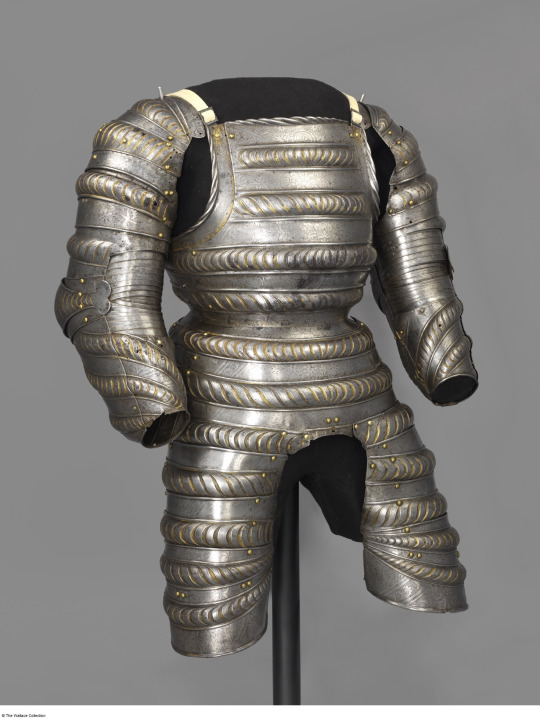


Though this fashion is synonymous with the landsknecht mercenaries who may have been responsible for popularizing it, the puffed and slashed style was enjoyed by members at all levels of society.

Portrait of Duke Henry of Saxony by Lucas Cranach the Elder, 1514, Staatliche Kunstsammlungen, Dresden.
The earliest of these three armors is housed at the Wallace Collection. Consisting only of a cuirass and arms, this armor is, at first glance, rather underwhelming when compared with the other armors in this group. Though the embossed bands styled with etched slashes embellished with gold provide the impression of a puffed and slashed doublet, the execution is all rather stiff, and lacks the impressive volume and fullness exemplified by the other armors.

It is for this reason that this armor, previously considered contemporary to the KHM and Metropolitan examples, has received relatively little attention. However, recent scholarship by Dr. Tobias Capwell suggests that this work is not, indeed, contemporary to the other examples, and is rather about ten years older, dating to ca. 1515. Dr. Capwell also considers this piece to be the work of Konrad Seusenhofer, a favored armorer of the Emperor Maximilian I.
Seen through this lens, not as a poorly executed contemporary of greater armors, but as a less developed ancestor to them, this armor takes on new life. It speaks to innovation and experimentation; an early attempt at a technique which would later be perfected.
The second in this line is the garniture of Wilhelm von Rogendorf, housed at the Kunsthistorisches Museum in Vienna.

This armor is unique for its condition, which is remarkably good. Not only does this armor retain more of its pieces than the other two, it is also accompanied by a number of “pieces of exchange,” elements which could be swapped out so the armor could be worn in the field.
Finished in 1523, as attested to by the date etched on the right shoulder strap, this armor was made for the Count Wilhelm von Rogendorf by Kolman Helmschmid and etched by Daniel Hopfer.

Wilhelm von Rogendorf himself was heir to a new, up-and-coming German noble family.

A medal showing Wilhelm von Rogendorf as a Knight of the Order of Calavatra, dated 1536, Kunsthistorisches Museum, Vienna.
Born in 1481 the second son of Kaspar von Rogendorf, Wilhelm became heir to his family’s estates when his elder brother Sigmund died in 1507, by which time Wilhelm was already a courtier at the Habsburg court. He entered into the service of King Charles I of Spain (later Emperor Charles V) no later than 1517 and was appointed Governor of Friesland. In 1522, Wilhelm accompanied Charles to Spain where he commanded a regiment of 4,000 landsknechts and was again placed in charge of a restless border territory. In 1524, he successfully captured the Fortress of Fuenterrabía from the French, which won him great praise from the Emperor. Shortly thereafter, Wilhelm was named Captain of the Imperial Bodyguard and given the governorships of Catalonia, the Cerdagne, and the Roussillon. Additionally, he was appointed to the Spanish chivalric Order of Calavatra. Wilhelm would retire from court in 1539, but would be recalled in 1541 to command Imperial troops against the Ottomans in Hungary. He would be killed later that same year at the siege of Buda by a stray cannonball.
Though Wilhelm’s armor is now displayed in its parade configuration, the surviving pieces of exchange attest to the fact that it was also an armor for combat. The cuirass is equipped with the long tassets common to the early 16th century. A pair of holes can be observed at the top of the last lame.

These holes correspond to holes at the top of the half-cuisses which accompany this armor, showing that these cuisses would be pointed to the tassets rather than worn separately.

In the rear, the cuirass is accompanied by a rump-defense, also known as a hoguine. Small turning pins near the waist allow this to be removed for combat.
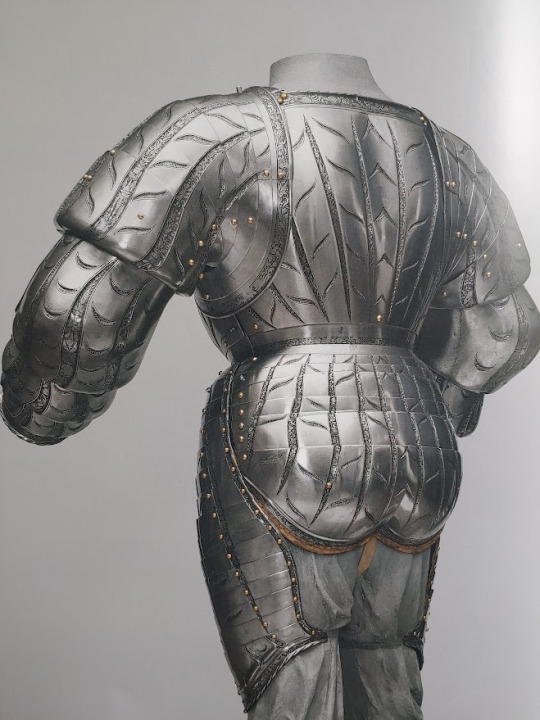
Both spaulders
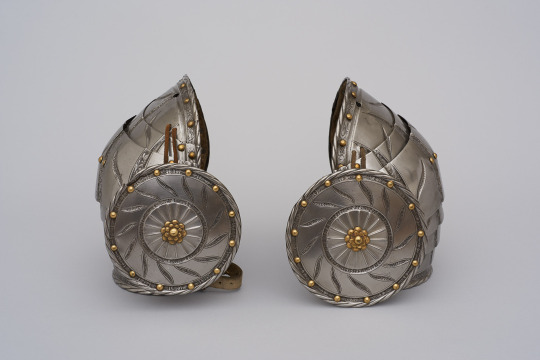
and gauntlets

survive. Additionally, the KHM retains the armor’s right vambrace

while the Wallace Collection holds the rerebrace and couter for the left arm.
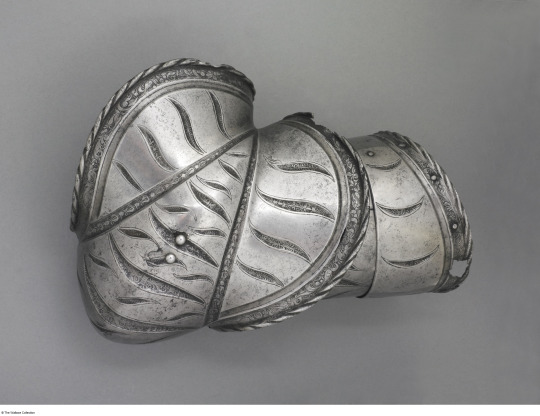
Recently, these pieces were assembled to show what the arm harness for field as a single unit would have looked like.
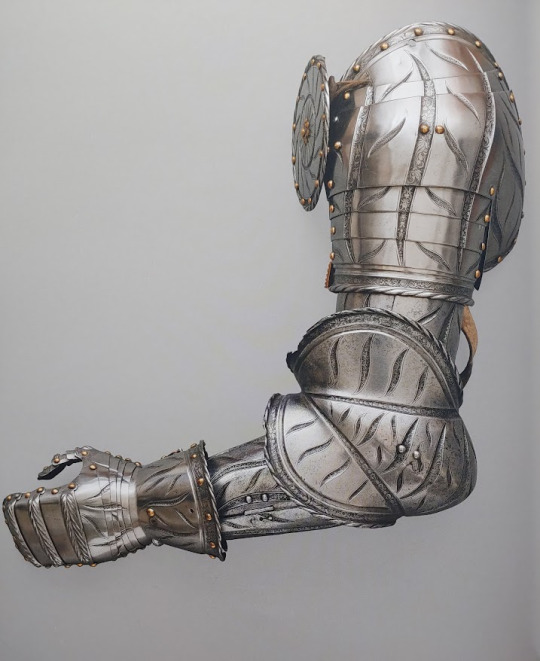
This armor would also have been accompanied by a gorget, now missing, and a helmet. Frequently, this armor is displayed alongside a close-helmet, however it is more likely the armor would have been accompanied by a burgonet similar in form to this example from the KHM.
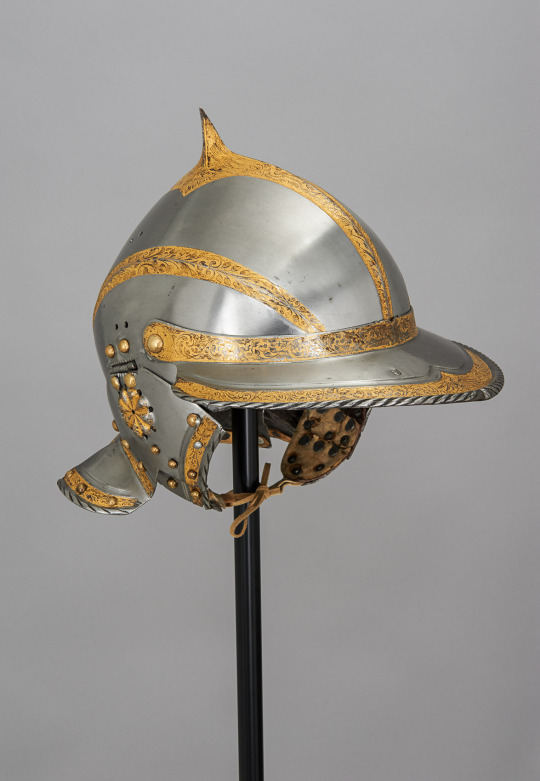
One final, unique surprise this armor holds is a hidden lance rest which is incorporated into the turned edge by the right arm. This rest folds down to allow a light lance to be braced atop it, and when folded up, is nearly invisible so as to not ruin the smooth surface of the breastplate with the prominent staples typically required for affixing a lance rest.

The third and final armor of this group is housed at the Metropolitan Museum of Art in New York City.

The least complete of these three armors, it may also be the most visually impressive. Comprised of only a backplate, hoguine, and arms, the puffs and slashes of this piece (also by Kolman Helmschmid and Daniel Hopfer) are ornately cusped. The slashed regions, displaying the gilded “fabric” beneath, and heavily etched to resemble an expensive silk brocade.
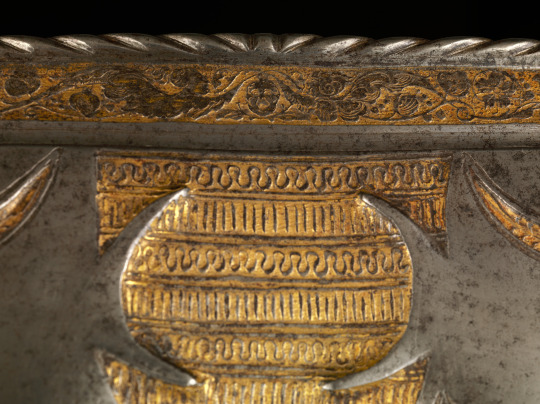
The sleeves of this armor are even more voluminous than those of the Rogendorf armor, though they are similarly articulated and provide the wearer with a surprising degree of mobility. It is thought that this armor may have been made for prominent Polish nobleman Jerzy Herkules Radziwill.
Interestingly, the hoguine of this armor is composed of two separate plates, rather than a single solid plate. Where the hoguine of the other two armors terminates in a decorative fabric border, the Met armor continues into two more articulated lames, covering the top rear of the thighs. Holes along the bottom edge suggest that this armor may have been accompanied by fully enclosing cuisses which pointed to the bottom of the fauld and hoguine.

Sources
“A Pair of Gauntlets.” Kunsthistorisches Museum Wien. https://www.khm.at/de/object/540164/.
“A Pair of Spaulders with Besagews.” Kunsthistorisches Museum Wien. https://www.khm.at/de/object/372772/.
Cranach, Lucas the Elder. “Portrait of Duke Henry of Saxony.” Staatliche Kunstsammlungen Dresden. https://skd-online-collection.skd.museum/Details/Index/246875.
Krause, Stefan. Fashion in Steel. Vienna: Kunsthistorisches Museum, 2017.
“Landsknecht Costume Armour.” Kunsthistorisches Museum Wien. https://www.khm.at/de/object/372771/.
“Left Upper Cannon and Couter.” The Wallace Collection. https://wallacelive.wallacecollection.org:443/eMP/eMuseumPlus?service=ExternalInterface&module=collection&objectId=60736&viewType=detailView.
“Open Burgonet.” Kunsthistorisches Museum Wien. https://www.khm.at/en/object/503346/.
“Parts of an Armour.” The Wallace Collection. https://wallacelive.wallacecollection.org:443/eMP/eMuseumPlus?service=ExternalInterface&module=collection&objectId=60519&viewType=detailView.
“Portions of a Costume Armor.” The Metropolitan Museum of Art. https://www.metmuseum.org/art/collection/search/27790.
“Vambrace.” Kunsthistorisches Museum Wien. https://www.khm.at/de/object/372773/.
“Wilhelm von Rogendorf.” Kunsthistorisches Museum Wien. https://www.khm.at/de/object/1409642/
.
#long post#armor#armour#landsknecht#costume armor#art#history#renaissance#germany#german#hre#holy roman empire#europe#european#themet#metmuseum#khm#skd#wallace collection
1K notes
·
View notes